Eight UNESCO Creative Cities and their development plans for the next four years

A summary of the Round Table Discussion under the topic “What Goals or Objectives Including Action Plans Will Your City be Achieving in the Next Four Years?” is another interesting event from the Bangkok Creative City Dialogue, held on February 10, 2023, during 13.30 - 15.30 hours. Taking part in the discussion were representatives from eight UNESCO Creative Cities Network (UCCN) countries, each of whom shared their ideas and knowledge on how to go about reaching their goals within the next four years to develop their respective creative cities. Also participating in this session were special invited guests from other overseas cities and those in Thailand.
The eight cities of the UNESCO Creative Cities Network are from three categories: Design, Crafts and Folk Art, and Gastronomy, comprising
1. Bangkok City of Design (Thailand)
2. Bandung City of Design (Indonesia)
3. Singapore City of Design (Singapore)
4. Seoul City of Design (South Korea)
5. Kuching City of Gastronomy (Malaysia)
6. Nagoya City of Design (Japan)
7. Asahikawa City of Design (Japan)
8. Perth City of Crafts and Folk Art (Scotland, United Kingdom)
When plans and objectives for the development of creative cities are clearly defined, it will certainly encourage all sectors of the economy to work together to drive these plans towards a common goal in a systematic manner. The roundtable discussion helped members and participants exchange valuable ideas, which in turn will promote even greater cooperation and closer ties within the network.
1. Bangkok City of Design (Thailand)

“The main responsibility of the Bangkok Metropolitan Administration (BMA) is to effectively manage the city in various issues including water, waste, and reinforcement of rules and regulations. As for the Creative Economy Agency, help and cooperation from creative individuals are much needed because we are not experts in this field. Working closely with CEA is therefore extremely important since it will help us think outside the box, and we can also gain a better understanding of designers and creative groups of people. The success of the Bangkok Design Week, which expanded to other parts of the city, is one of the highlights of CEA’s performance.
The plan for the next four years may not be well defined at this point, but we are committed to making Bangkok a city that is good and happy to live in. We will not deny that today, Bangkok may be attractive to some but not to everyone. There are quality restaurants, public parks, and accommodations, but we can still find small, crowded communities located at different spots throughout the city. Public transportation is not all that convenient and extensive. Flooding remains one of the critical problems because the administrative structure is not quite complete. Although there are networks and functions that work together to tackle this problem, the coordination between units is not satisfactory. That’s why we need to amend our policies, and I believe design is one of the elements that can answer our problems.
Looking from the perspective of being a creative city, one of the challenges is the neglected areas around Bangkok, and therefore BMA must take care of both the hardware and software elements. By that, I mean our city’s structure must be as strong as its people. One of the examples I’d like to mention here as far as the city structure is concerned is the relocation of City Hall. It is not just about moving its location; it also means an adjustment of the old city plan, where we need to make a thorough and careful consideration of how to take care of the surrounding communities. On the so-called software element, we are working hard to promote individual identities for all 50 districts around Bangkok, which we need to discuss in detail with the designers. Another important issue is how to make a brand of Bangkok more distinctive by creating one single picture of Bangkok for everyone. All of these are what we aim to achieve within the next four years.”
Sanon Wangsrangboon
Deputy Governor of Bangkok
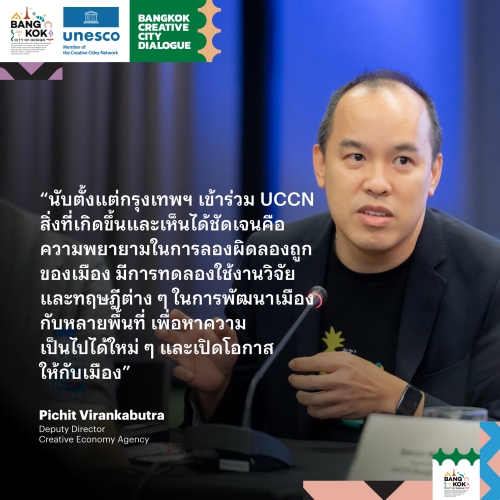
“Since Bangkok was selected as a member of the UCCN, it was clear that many attempts were made through research and theories to develop many areas in the city. The Bangkok Creative City Dialogue is one of the tools in our attempts to use new and more innovative ways to introduce new opportunities for Bangkok. Our projects to revive unattended space and deserted buildings in the community, where the residents are entrusted with the responsibilities of these places, will have to be monitored to determine whether they will yield a sustainable result. We would like to see every district in Bangkok make an attempt to create their own community asset. Not every district will follow the same method, of course, but we would like to encourage greater learning from one another so that they can come up with their own model suitable for the people and existing assets in building their own identity.
We have been working along this path for the past four years and will continue to move forward in the same direction. CEA and BMA are working in close cooperation, and meetings are held on a regular basis to discuss many critical issues. There are a number of new projects coming up, including the recent opening of a new public park in the heart of the city last year. I would like to emphasize that BMA fully realizes the importance of providing green areas for city people, and I believe that creativity and design can give us tangible outcomes. In the next few years, I am certain that we will see many changes happening in Bangkok with strong support from CEA in areas of creativity and design for our future projects to become reality. Despite the challenges ahead, such as floods and traffic congestion, I believe that we can provide better living conditions for the people in Bangkok. But we need all the necessary cooperation and information to move forward and find the best possible solutions to make Bangkok even more attractive for living.”
Pichit Virankabutra
Deputy Director
Creative Economy Agency
2. Bandung City of Design (Indonesia)
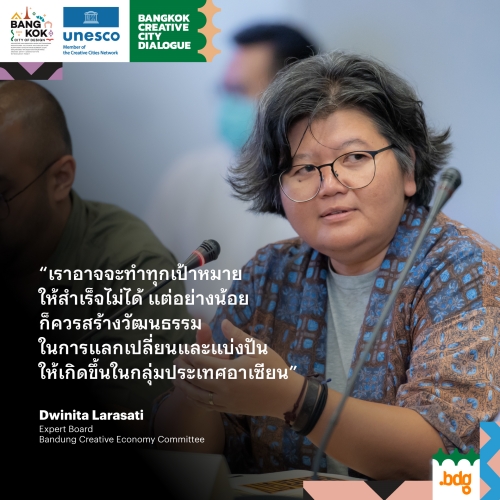
“I’m afraid that I may not be able to provide definite answers on our part at this point because the general election will take place in the next two years in various towns. Therefore, we need to be sure that the new government will follow the plans that were established prior to the election. In case the new government is unable to follow the plan within the set time frame, we may have to make necessary adjustments accordingly. However, we have the performance guidelines and manuals that determine the government KPIs which will assist in better coordination. We fully understand that Bandung has to adjust itself according to the situation and set priorities for what should come first in case any unexpected circumstances arise. We must communicate with the people, making them recognize the importance and benefits of a creative economy focusing on a robust value chain and using creativity to boost economic recovery.
As for Bandung itself, there are many functions and units involved in this matter. But this is not as important as establishing clear goals and an index that are not aimed at measuring which town is more creative or creating a competitive environment. On the contrary, it aims to build greater understanding among the people of how far Bandung has come as far as creativity is concerned, and to identify our weak and strong points. We need to learn how to use the database effectively to improve our city. Many of the towns in Bandung embrace lush natural resources, and if we do not know how to use them for our benefit, it will be a great loss.
At present, there are two main issues in ASEAN that we must make them happen. The exchange of information and knowledge between countries and the appointment of ASEAN representation that does not belong to any one country must be encouraged. One of these two issues may help bring closer cooperation between ASEAN member countries and create unity within these nations. The co-create creative art projects or other subjects to communicate with the people in ASEAN countries to receive the same message and for the people around the world to see the same picture. It is important that we push important agendas to the ASEAN level through collaboration with the Ministry of Foreign Affairs of each country. At the ASEAN Summit, we presented the issues of creativity and culture. We may not be able to reach all the goals we desire, but the least we can do is establish a culture of exchanging knowledge and information within ASEAN.”
Dwinita Larasati
Expert Board
Bandung Creative Economy Committee
3. Singapore City of Design (Singapore)

“We may not be able to provide a clear picture of the four-year plan as Singapore has established a five-year preliminary plan. Therefore, the 2023 preliminary plan is included in that, which extends to the year 2025, which is in the operating stage and being reviewed to see if any amendments are needed. Talking about the targets that we aim for in 2023, we expect to use design to make Singapore even more attractive and loveable for living, and introduce innovations to make Singapore more competitive in the international arena.
We must build a design brand in Singapore style that will be accepted in terms of quality and excellence. The reason we focus on success at the international level rather than at the domestic level is because of the nature of Singaporeans, who will admire domestic works and efforts only when they are accepted at the international stage. So, it is important that we adjust our targets and procedures according to people’s characteristics.
In working with the private sector for many years, I would say we have succeeded and met our targets. But when we get to a certain stage, we need to raise the working standard and actually make it a reality to move forward. We have already envisaged the way forward to 2030, what needs to be done, and have a clear picture in our minds that design must benefit other dimensions of the economy than just generating revenue. Design must help complement and support innovation, create social value, and reflect the core value of its existence. In addition, design must help promote the potential of government units, technological development, and research and development. Also, we must be able to answer why we are doing this and for whom. Innovation is not just about creating something; but it shows that we build all these to serve what purpose and what are the likely impacts they may cause.”
Kelly Tan
Deputy Director
Market Development, Design Singapore Council
4. Seoul City of Design (South Korea)

“Seoul Design Foundation is a non-governmental organization working in support of the government sector, using knowledge and experience in working with various design-related functions and organizing a number of projects. I am very impressed to learn that our people are ready to welcome new things, and I am amazed that these people have such great vision and minds that they have gone beyond where we are now in many aspects. We must keep up with the fast-changing environment in order to make the best possible evaluation and assumption of what will happen in the future.
Similar to Singapore, we try to provide a space for discussion about what we have and the development of innovation in various areas, such as the light and sound show. Initially, we thought it would not be possible to organize the show on surfaces with strange figures and shapes at Dongdaemun Design Plaza. But when we actually talked about it in greater detail, it became apparent that the technology we have is readily available, plus the people are very open to welcoming new things. So, we must be bold enough to present novel projects for the people. Although we may not be able to provide clear answers to what we will do in the next four years, what I can say at this point is that we will continue to bring new things to the people, as we always do, to move forward and build a better future for our people.”
Ayoung UM
Team Leader
Seoul Design Foundation
5. Kuching City of Gastronomy (Malaysia)

“Community engagement is important. If there were no community, then it would not be necessary to have a government. Therefore, whichever plans we are making, the benefit of the people must be the first priority. It is important to provide opportunities for people to express their feelings and ideas. This is, of course, a lengthy process, but it is the only way to make the people feel that they are part of the community and have a role to play. This is the reason for establishing the city council, which has the responsibility of following up on the city’s projects and policies as well as coordinating between UCCN and the Chairman of the Board, the position of government minister. Our work will always involve these two levels of entities in parallel.
I am pleased to say that we have completed our draft plans for the next four years, which will be presented to the government and stakeholders so that they know the direction in which we are moving. There will be a review of the results each year to determine whether any improvements or changes are needed in order to ensure that we can accomplish the goal we may have missed. Also, I would like to see closer cooperation between members. Kuching became part of the UCCN not long ago, so we are in search of partners with whom we can exchange ideas for better results since creativity must come from different industries. At this point, we only see the high potential of the food industry because food is something that everyone needs. But what’s more interesting is how to connect food to culture, community, and history to create stories and interests. There is more to food consumption than meets the eye. I would like to see a chef exchange project so that we can gain a better understanding of our stakeholders, and we can also apply this idea to the travel and tourism industries.
We also set up food projects for health and hygiene to promote better understanding among young generations of food and fresh markets. Visitors are able to learn to make both hygienic and delicious dishes and understand the selection of raw materials. As for the farmers, we focus on the raw materials from Sarawak, as it is the location that embraces high quality raw materials. At the same time, we are trying to create the identity of raw materials in each location through the use of creativity. If we were able to bring creativity into reality, connecting food with people’s lives and feelings, it means that we can exercise creativity at its full capacity, bringing with it innovation and fame to our city.”
Dato Wee Hong Seng
Mayor of Kuching South
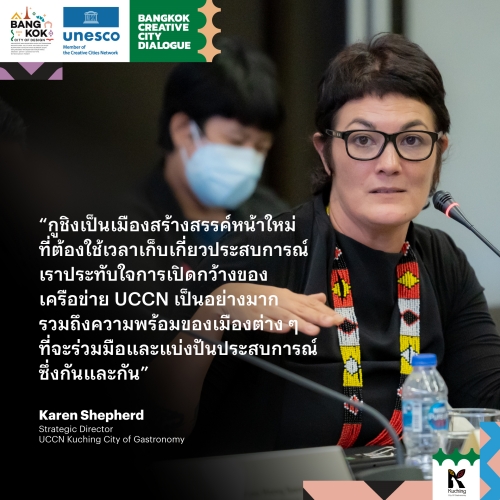
“Creativity is our direct responsibility, even though we are not the ones behind the steering wheel and pressing the accelerator ourselves, so to speak. But what we do is provide directions. Adding to what we do, there are functions under the government that are directly responsible for this matter. So, there are many projects that do not belong to us, and what we do is more like connecting and coordinating with those involved and bringing them closer together. In exercising a project, the progress made by those involved will be different. As a UCCN function, we will take on the role and responsibility of coordinating between relevant functions to ensure that the work runs smoothly and at the same pace.
Talking about the benefits that we have established as a member of UCCN, the answer would be that we are able to promote cooperation among those involved in order to reach our common goal and that our voices are heard by the government. Being a representative of this network is very important because every activity and project carried out under the UNESCO umbrella will create a balance between the government’s creative industry and private entities. I cannot say it is my own achievement. The results and outcome happened as they should. The UCCN helps facilitate and offers a platform for all stakeholders within the country and overseas to discuss and exchange views.
Kuching is a relatively new creative city, and we will need time to gain more experience and knowledge. If any country is, by any chance, looking for a partner, we are ready for further discussion on this. Kuching still needs to make itself better known, and we need support and cooperation at the international level. I must say that we are very impressed by the extensive coverage of this network as well as the readiness of other member countries to cooperate and share experiences with other members. It is truly eye-opening for us to be part of the network. In our first year of being part of the UCCN (2022), we organized a gastronomy event within the country, and therefore, for the second year (2023), we will certainly invite guests from other countries to join as well.”
Karen Shepherd
Strategic Director
UCCN Kuching City of Gastronomy
6. Nagoya City of Design (Japan)

“For more than 14 years since Nagoya was selected to be a member of the UCCN in 2008, we have received a lot of contacts from different cities, some of which we never knew before. Because of that, we have been able to establish and expand our network and relationships with many new cities. Nagoya University also had the opportunity to organize campaigns in cooperation with other universities in the form of exhibitions and events. This is clearly one of the benefits we gain from being part of the UCCN. However, the challenge we are facing is to ensure continuity of our work in parallel to creating awareness among the people, especially the continuity of projects that we established with the local government, since there are various critical factors involved.
As for our plans for the next four years, last October, we initiated projects that focused on design and city development. Our plans have also placed special emphasis on research, support for the performing arts, and listening to people’s views and ideas. This way, we are able to collect important information and data prior to conducting any research or launching projects. We are also committed to making UCCN a stronger network and bringing greater benefits to the people. Although organized events prove to be beneficial, not all of them do. We must take into consideration how each event will actually benefit the people because the people need to realize what we do will truly benefit them.”
The next issue here is the management of cultural heritage. We need to find harmonious integration between people and culture. Nagoya is rich in raw materials such as earth for making high quality earthenware and wood crafts. Nagoya is also a port city, where the transportation of goods and cargo radiates from here to other countries around the world. Nagoya is well-known for its industrial importance, but its historical significance has gradually diminished although Nagoya is a city with a long-standing reputation for its historic importance. Today we have the problem of successors for the earthenware legacy. Therefore, creating human resources as successors to the city’s legacy is of utmost importance and needs to be an ongoing task. In conclusion, we need to provide support to new industries in line with maintaining the city’s industrial heritage.”
Eriko Esaka
Program Director
Nagoya, UNESCO City of Design Organizing Committee
7. Asahikawa City of Design (Japan)
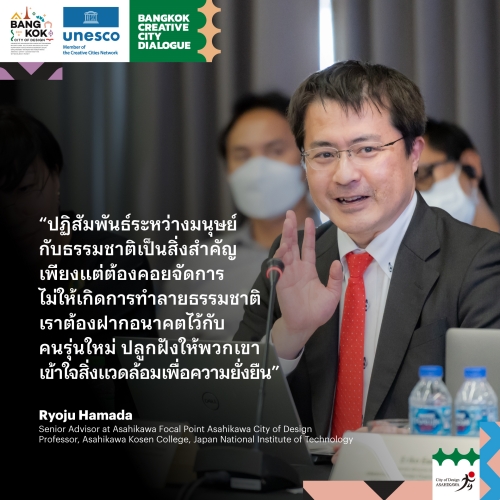
“Asahikawa is situated in Hokkaido, which is considered a new region of Japan. Established in 1860, Hokkaido is rich in natural resources, but the temperature is quite cold and can reach minus 20 degrees Celsius at certain times of year. We want to maintain nature’s richness and lush environment in a sustainable manner. However, environmental preservation solely is not enough; we need to simultaneously ensure the development of the people through the power of design. Without human resources, the environment will remain as it is without generating any added value. People are therefore needed to manage the environment effectively to render greater benefits.
For example, during the outbreak of COVID-19, we launched a project to encourage people to rest and work at the same time, which we call the Workation Project in Hokkaido, which aimed to stimulate economic growth. Interaction between humans and nature is therefore very important and requires effective management to prevent any environmental damages. We leave the future to the young generation, creating awareness and understanding of the importance of our environment. Students in secondary school are encouraged to study the United Nations’ Sustainable Development Goals (SDGs). It is neither a compulsory subject in the school curriculum nor part of a university’s exam papers, but we want them to learn how we can take care of our world and society.
Asahikawa has established a learning center that provides information about this subject. We are proud to be part of the UCCN as it offers many new and exciting opportunities for a small city in Hokkaido like ours.”
Ryoju Hamada
Senior Advisor at Asahikawa Focal Point
Asahikawa City of Design
Professor, Asahikawa Kosen College, Japan National Institute of Technology
8. Perth City of Crafts and Folk Art (Scotland, United Kingdom)
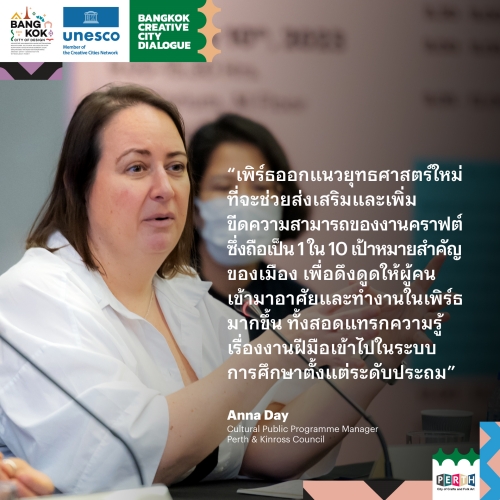
“Visits to places and opportunities to meet our peers in UCCN member countries are of great benefit to us. Personally, I see that organized projects or campaigns within the network will have the best outcome if we are able to meet and talk among ourselves. Participating in events may not be that necessary for the work we are doing, but we have the chance to gain many new ideas. I can fully say to those who just joined or are thinking of joining the network that you will definitely find it most beneficial to your city, and you will gain many new experiences and support from other cities.
As for Perth, building community engagement in the UCCN or groups of craftsmen remains one of the great challenges. It may be because Perth is a secondary city that we still lack the active personnel and workforce to visit other cities or join this network. This is the main reason that we should seek as many partners as we possibly can, because working with the government sector, whether local or UNESCO, requires effective and close coordination. As far as the policy issue is concerned, Perth has just introduced new strategies to promote crafts and crafts-related events are among the top ten most important targets of our city. This will enable us to raise our competency in organizing this kind of event and allocate suitable resources in support of such an activity.
In Perth, we still need more work on education because there are no universities in Perth. This is the reason why young generations move to other cities to further their education or for work. This is one of the major problems in Perth that needs to be tackled. So, we try to include knowledge on crafts and arts into the academic system from the primary level with the hope of stimulating their interest and encouraging them to live and work in Perth. All of these are part of the plans we aim to achieve in the next four years.”
Anna Day
Cultural Public Programme Manager
Perth & Kinross Council

